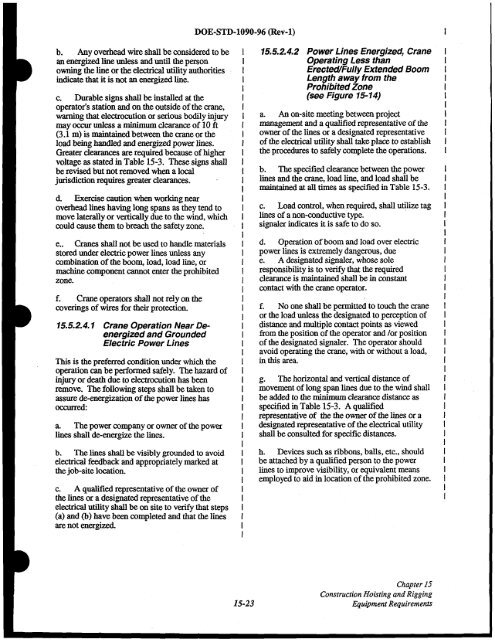DOE-STD-1090-96, DOE Standard Hoisting and Rigging Manual ...
DOE-STD-1090-96, DOE Standard Hoisting and Rigging Manual ...
DOE-STD-1090-96, DOE Standard Hoisting and Rigging Manual ...
You also want an ePaper? Increase the reach of your titles
YUMPU automatically turns print PDFs into web optimized ePapers that Google loves.
<strong>DOE</strong>-<strong>STD</strong>-I090-<strong>96</strong> (Rev-I)b. Any overhead wire shall be considered to be Ian energized line unless <strong>and</strong> until the person Iowning the line or the electrical utility authorities Iindicate that it is not an energized line.IIc. Durable signs shall be installed at the Ioperator's station <strong>and</strong> on the outside ofthe crane, Iwarning that electrocution or serious bodily injury Imay occur unless a minimum clearance of 10 it ((3.1 m) is maintained between the crane or the Iload being h<strong>and</strong>led <strong>and</strong> energized power lines. IGreater clearances are required because ofhigher Ivoltage as stated in Table 15-3. These signs shall Ibe revised but not removed when a localIjurisdiction requires greater clearances.IId. Exercise caution when working near Ioverhead lines having long spans as they tend to Imove laterally or vertically due to the wind, which Icould cause them to breach the safety zone. IIe.. Cranes shall not be used to h<strong>and</strong>le materials Istored under electric power lines unless any Icombination ofthe boom, load, load line, or Imachine component cannot enter the prohibited Izone.IIf. Crane operators shall not rely on the Icoverings ofwires for their protection.II15.5.2.4.1 Crane Operation Near Deenergized<strong>and</strong> GroundedElectric Power LinesThis is the preferred condition under which theoperation can be performed safely. The hazard ofinjury or death due to electrocution has beenremove. Thefollowing steps shall be taken toassure de-energization ofthe power lines hasoccurred:a. The power company or owner ofthe powerlines shall de-energize the lines.b. The lines shall be visibly grounded to avoidelectrical feedback <strong>and</strong> appropriately marked atthe job-site location.c. A qualified representative ofthe owner ofthe lines or a designated representative oftheelectrical utility shall be on site to verify that steps(a) <strong>and</strong> (b) have been completed <strong>and</strong> that the linesare not energized.15.5.2.4.2 Power Lines Energized, CraneOperating Less thanErected/Fully Extended BoomLength away from theProhibitedZone(see Figure 15-14)a. An on-site meeting between projectmanagement <strong>and</strong> a qualified representative oftheowner ofthe lines or a designated representativeofthe electrical utility shall take place to establishthe procedures to safely complete the operations.b. The specified clearance between the powerlines <strong>and</strong> the crane, load line, <strong>and</strong> load shall bemaintained at all times as specified in Table 15-3.c. Load control, when required, shall utilize taglines of a non-conductive type. .signaler indicates it is safe to do so.d. Operation ofboom <strong>and</strong> load over electricpower lines is extremely dangerous, duee. A designated signaler, whose soleresponsibility is to verify that the requiredclearance is maintained shall be in constantcontact with the crane operator.f. No one shall be permitted to touch the crane Ior the load unless the designated to perception of Idistance <strong>and</strong> multiple contact points as viewed Ifrom the position ofthe operator <strong>and</strong> lor position Iofthe designated signaler. The operator should Iavoid operating the crane, with or without a load, Iin this area.IIg. The horizontal <strong>and</strong> vertical distance of rmovement oflong span lines due to the wind shallbe added to the minimum clearance distance asspecified in Table 15-3. A qualifiedrepresentative of the the owner ofthe lines or adesignated representative ofthe electrical utilityshall be consulted for specific distances.h. Devices such as ribbons, balls, etc., should Ibe attached by a qualified person to the power Ilines to improve visibility, or equivalent means Iemployed to aid in location ofthe prohibited zone. IIIIIIJIIIIIJI15-23Chapter 15Construction <strong>Hoisting</strong> <strong>and</strong> <strong>Rigging</strong>Equipment Requirements
















